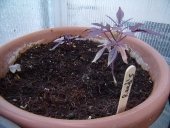
 5
5




Nothing ruins a neighborhood like paved roads and water lines.
 6
6




Nothing ruins a neighborhood like paved roads and water lines.
 6
6




Nothing ruins a neighborhood like paved roads and water lines.
 3
3




Dennis Bangham wrote:My wife loves the Asian (white flesh) Sweet Potato. I have taken over almost all of the garden area and left little room for her to grow these. Can they be made to grow in vertical tubes made out of fencing? Leaves then dirt then wood chips and repeat.
"Never be within doors when you can rightly be without." ~ Charlotte Mason
 6
6




"Never be within doors when you can rightly be without." ~ Charlotte Mason
 5
5




Dennis Bangham wrote:My wife loves the Asian (white flesh) Sweet Potato. I have taken over almost all of the garden area and left little room for her to grow these. Can they be made to grow in vertical tubes made out of fencing? Leaves then dirt then wood chips and repeat.
Nothing ruins a neighborhood like paved roads and water lines.
 3
3




 6
6




Nothing ruins a neighborhood like paved roads and water lines.
 1
1




Mark Reed wrote:It's been a good bit since I updated this topic. Project is ongoing and doing pretty well. I started more seeds than ever this year and sort of bit of more than I could chew in some ways. I learned quite a bit I didn't know before, one of which is I'm terrible at making videos but here one is at harvest time thig year.
 9
9




Jonathan de Revonah wrote:
Any notable updates from 2023 for this project, Mr. Reed?
Nothing ruins a neighborhood like paved roads and water lines.
 2
2




 3
3




Jonathan de Revonah wrote:Mark,
1) In what region/hardiness zone are you located? How far north do you think growing sweet potatoes from seed/to flowering can be successfully accomplished? Has any progress been made by you or others regarding improving cold-hardiness or faster-maturing?
Jonathan de Revonah wrote:
2) Do you have seeds or slips available for purchase or trade?
Jonathan de Revonah wrote:
3) Do you do anything to coax the plants to flower?
Nothing ruins a neighborhood like paved roads and water lines.
 1
1




 1
1




Ashley Lutz wrote:Mark are your sweet potato seeds for sale anywhere? Right now sweet potatoes are a non-viable crop as far north as I am but I’d love to try those seeds and see what happens.
 1
1




Ashley Lutz wrote:
Ashley Lutz wrote:Mark are your sweet potato seeds for sale anywhere? Right now sweet potatoes are a non-viable crop as far north as I am but I’d love to try those seeds and see what happens.
My apologies, I see you’ve already answered this question recently. It’s a fascinating project, keep us posted if seed does come up for sale!
 1
1




 3
3




 13
13




Nothing ruins a neighborhood like paved roads and water lines.
 3
3




'What we do now echoes in eternity.' Marcus Aurelius
How Permies Works Dr. Redhawk's Epic Soil Series
 4
4




Nothing ruins a neighborhood like paved roads and water lines.
 6
6




Nothing ruins a neighborhood like paved roads and water lines.
 4
4




Nothing ruins a neighborhood like paved roads and water lines.
 2
2




Mark Reed wrote:Just another little video about my sweet potatoes.
 5
5




"We're all just walking each other home." -Ram Dass
"Be a lamp, or a lifeboat, or a ladder."-Rumi
"It's all one song!" -Neil Young
 4
4




"We're all just walking each other home." -Ram Dass
"Be a lamp, or a lifeboat, or a ladder."-Rumi
"It's all one song!" -Neil Young
 9
9




I wonder what size pots you use to grow in ground?
I might have missed this info but is there any difference in the potato crop when waiting for seed to mature?
Nothing ruins a neighborhood like paved roads and water lines.
 10
10




Nothing ruins a neighborhood like paved roads and water lines.

| I agree. Here's the link: http://stoves2.com |








